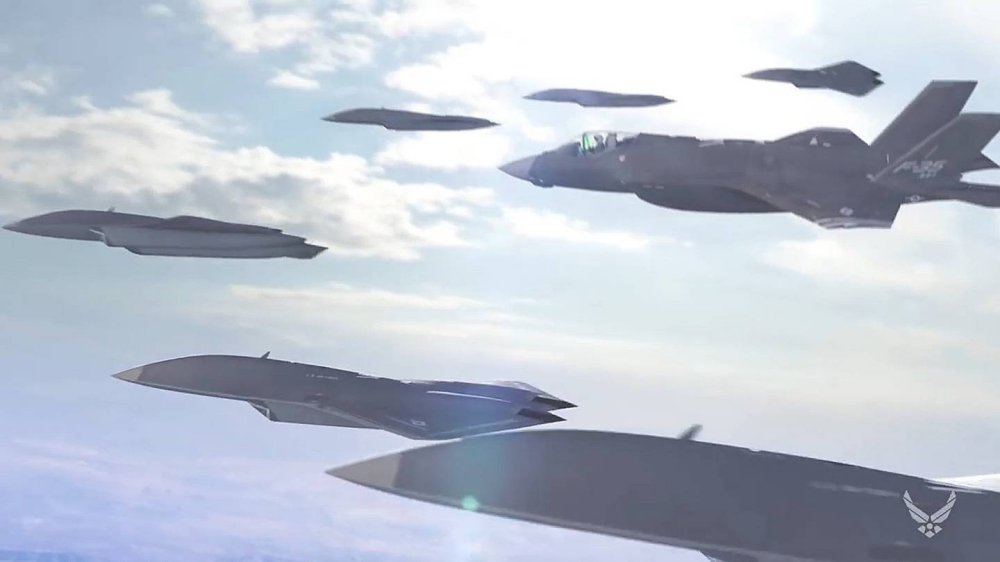As part of a broader initiative to invigorate its advanced science and technology work and promote increased partnerships with academia, the U.S. Air Force has released a short video depicting how it thinks aerial warfare might look by the end of the next decade.
It’s a futuristic, but in many ways incomplete vision full of advanced stealthy manned jets, semi-autonomous unmanned combat air vehicles, lasers and other directed energy weapons, and a potentially artificial intelligence-enabled network backbone that brings it all together.
The Air Force Research Laboratory (AFRL), one of the service’s top research and development arms, put the clip online earlier in March 2018 as a “call to action” for the Air Force 2030 project. Secretary of the Air Force Heather Wilson first announced this plan at the Air Force Association’s main annual convention and exhibition in 2017, which also marked the Air Force’s 70th year in existence.
“We will listen broadly and engage those who are on the cutting edge of science so that we can focus our research efforts on the pathways that are vital to our future as a service,” she said in her keynote address on Sept. 18, 2017. “At a time when federal research funding may be uncertain we want the United States Air Force to be the sponsor of choice for research scientists.”
But it’s clear that AFRL, and the Air Force as a whole, already has some understanding of the kind of capabilities it is most interested in pursuing. After giving a brief overview of the service’s already significant history of science and technology research and development work, the Air Force 2030 video cuts to a computer generated montage of advanced air warfare concepts.
Loyal Wingmen
The first scene depicts an F-35A Joint Strike Fighter working together with six stealth unmanned combat air vehicles, or UCAVs. For years now, the Air Force, and AFRL in particular, has been working on this type of manned-unmanned teaming, which it has referred to as the “Loyal Wingman” concept.
In 2015, Lockheed Martin, in cooperation with the CalSpan Corporation, demonstrated the ability of a two-seat Block 50 F-16D Viper to safely fly in formation with a modified unmanned F-16 test bed, known as the Variable stability In-flight Simulator Test Aircraft, or VISTA. At times during that test,known Have Raider, the drone Viper also broke off, followed a pre-determined route independently, and then re-entered formation with the manned aircraft.
Two years later, during a follow on experiment called Have Raider II, the pair of aircraft actually went through the motions of a simulated strike mission. The pilotless F-16 attacked simulated targets on the ground autonomously based on an established set of parameters, but also modified its flight pattern in response to mock threats and other changing environmental conditions.
AFRL has since released concept art of a more purpose built drone wingman under a project called Low Cost Attritable Aircraft Technology (LCAAT). That design looked very similar to the XQ-222 Valkyrie, a multi-purpose unmanned aircraft from drone maker Kratos that the U.S. Air Force also calls the XQ-58A.
Kratos recently received approval to export its less advanced UTAP-22 Mako drone, which it has tested in a loyal wingman role in the past with a U.S. Marine Corps AV-8B Harrier, which suggests that there could be more advanced designs from that company or others in a relatively mature state already available to the Air Force. With some notable exceptions, the United States is typically not inclined to make military systems available even to allies that are directly equivalent to its own top-end capabilities.
Stealthy unmanned attackers
The March 2018 video shows much more advanced loyal wingmen with completely tailless, low-observable planforms, internal weapons bays, and an in-flight refueling receptacle on top of the fuselage. Both the Air Force and the U.S. Navy have demonstrated the ability to refuel an unmanned aircraft in mid-air and the former service may have actually deployed drones with this capability.
Coupled with mid-air refueling, such a force could potentially penetrate deep into denied enemy areas full of integrated air defenses and advanced hostile fighter aircraft to destroy critical or time sensitive targets. The group would also be able to strike at those defenses, helping open up a safer path for subsequent strikes by more vulnerable non-stealthy aircraft.
In the video, the pilot in the F-35A uses the aircraft’s advance sensor suite to detect a surface-to-air missile site and orders some of his drone companions to attack it with what appears to be a GBU-39/B Small Diameter Bomb (SDB) glide bomb. This combination of a manned low-observable plane directing stealthy UCAVs to hit a target with a stand-off weapon shows just how much distance a pilot might be able to put between themselves and a threat with this operating concept.
Similar operating concepts could apply in air-to-air combat, as well, with the drones acting as missile trucks, engaging targets based on information from the controlling F-35 or another manned or unmanned asset loaded with sensors. It could also potentially help with the Air Force’s chronic pilot shortage by significantly expanding the capabilities a single manned aircraft can bring to bear across a broad area.
Source: The Drive

